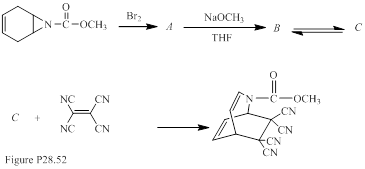
Organic Chemistry, Ebook And Single-course Homework Access
6th Edition
ISBN: 9781319085841
Author: LOUDON
Publisher: MAC HIGHER
expand_more
expand_more
format_list_bulleted
Question
Chapter 28, Problem 28.52AP
Interpretation Introduction
Interpretation:
An interesting heterocyclic compound C was prepared and trapped by the sequence of reactions given in Fig. P28.52.The structure of all missing compounds is to be explained.

Concept introduction:
Electrocyclic reactions are a pericyclic reaction which occur intramolecularly. These reactions will result in the formation of ring compounds under the influence of heat or light. Notably, in this process one new sigma bond is formed and one old π-bond is consumed. Intriguingly, the reverse ring opening electrocyclic reaction can also be possible to occur under the same reaction mechanism but in reverse manner.
Expert Solution & Answer
Want to see the full answer?
Check out a sample textbook solution
Students have asked these similar questions
Can I get some help drawing my arrows. I included what the final needs to look like
please help
(a)
(e)
O₂N.
(h)
21.8 Name the following compounds.
Br
(f)
Ph.
(c)
(d)
Br
(g)
NO₂
H
NH2
Br
mo. 0-0.
OMe
(i)
Chapter 28 Solutions
Organic Chemistry, Ebook And Single-course Homework Access
Ch. 28 - Prob. 28.1PCh. 28 - Prob. 28.2PCh. 28 - Prob. 28.3PCh. 28 - Prob. 28.4PCh. 28 - Prob. 28.5PCh. 28 - Prob. 28.6PCh. 28 - Prob. 28.7PCh. 28 - Prob. 28.8PCh. 28 - Prob. 28.9PCh. 28 - Prob. 28.10P
Ch. 28 - Prob. 28.11PCh. 28 - Prob. 28.12PCh. 28 - Prob. 28.13PCh. 28 - Prob. 28.14PCh. 28 - Prob. 28.15PCh. 28 - Prob. 28.16PCh. 28 - Prob. 28.17PCh. 28 - Prob. 28.18PCh. 28 - Prob. 28.19PCh. 28 - Prob. 28.20PCh. 28 - Prob. 28.21PCh. 28 - Prob. 28.22PCh. 28 - Prob. 28.23PCh. 28 - Prob. 28.24PCh. 28 - Prob. 28.25PCh. 28 - Prob. 28.26PCh. 28 - Prob. 28.27PCh. 28 - Prob. 28.28PCh. 28 - Prob. 28.29APCh. 28 - Prob. 28.30APCh. 28 - Prob. 28.31APCh. 28 - Prob. 28.32APCh. 28 - Prob. 28.33APCh. 28 - Prob. 28.34APCh. 28 - Prob. 28.35APCh. 28 - Prob. 28.36APCh. 28 - Prob. 28.37APCh. 28 - Prob. 28.38APCh. 28 - Prob. 28.39APCh. 28 - Prob. 28.40APCh. 28 - Prob. 28.41APCh. 28 - Prob. 28.42APCh. 28 - Prob. 28.43APCh. 28 - Prob. 28.44APCh. 28 - Prob. 28.45APCh. 28 - Prob. 28.46APCh. 28 - Prob. 28.47APCh. 28 - Prob. 28.48APCh. 28 - Prob. 28.49APCh. 28 - Prob. 28.50APCh. 28 - Prob. 28.51APCh. 28 - Prob. 28.52APCh. 28 - Prob. 28.53APCh. 28 - Prob. 28.54APCh. 28 - Prob. 28.55AP
Knowledge Booster
Similar questions
- Can I get helpp drawing my arrowsarrow_forwardWhich of the m/z values corresponds to the base peak in the mass spectrum shown? 100 80 A. 45 B. 44 C. 29 D. 15 Intensity 20 0 10 20 30 40 B- m/z -8 50 E. 30 Which of the m/z values correspond to the molecular ion for the compound shown? A. 18 B. 82 OH C. 100 D. 102 E. 103arrow_forwardCan someone help me with drawing my arrows.arrow_forward
- I'm having trouble with converting lewis diagrams into VSEPR diagrams. I currently have this example of C2BrCl3 which I want to turn into a lewis structure, but I'm not sure what steps I need to do in order to do so. I have the table written down, however, there's two central atoms so what would I do? There seems to be 4 electron domains on the carbon atom and no lone pairs so it would seem like this shape would be tetrahedral. Here's what I have now. Thanks!arrow_forwardWe discussed the solid phase resin using in peptide synthesis. Provide a mechanism, for its formation. DRAW THE MECHANISM.arrow_forwardPlease help. Every time I've asked an expert in the past, it's been wrong :(arrow_forward
arrow_back_ios
SEE MORE QUESTIONS
arrow_forward_ios
Recommended textbooks for you
 Organic ChemistryChemistryISBN:9781305580350Author:William H. Brown, Brent L. Iverson, Eric Anslyn, Christopher S. FootePublisher:Cengage Learning
Organic ChemistryChemistryISBN:9781305580350Author:William H. Brown, Brent L. Iverson, Eric Anslyn, Christopher S. FootePublisher:Cengage Learning

Organic Chemistry
Chemistry
ISBN:9781305580350
Author:William H. Brown, Brent L. Iverson, Eric Anslyn, Christopher S. Foote
Publisher:Cengage Learning